Text

Somehow, The Students of SHIELD Tumblr Returned.
3 notes
·
View notes
Text
Strange Tales: A Doctor Strange Publication History Lesson Part 3, A Separate Reality

By Vincent Faust
Strange then jumped from anthology/tryout title Marvel Feature to Marvel Premiere. He was the lead feature here from 3-14. Starting with Marvel Premiere 9, Steve Englehart started writing Strange’s solo stories.
All of the above information has been primarily sourced from good olde Wikipedia (a totally legitimate source), the dark recesses of my own brain, the Marvel Wikia, this Polygon article, and most importantly Neilalien.com which is a fantastic Doctor Strange fansite.
#Vincent Faust#dr strange#doctor strange#dr. strange#steve englehart#frank brunner#a separate reality#mcu#marvel cinematic universe
2 notes
·
View notes
Text
Strange Tales: A Doctor Strange Publication History Lesson Part 2, Roy Thomas and the Masked Doctor

By Vincent Faust
Steve Ditko left the Doctor Strange feature after Strange Tales 146. This coincided with Amazing Spider-Man 38, marking his mysterious and silent overnight departure from Marvel Comics. Some diehard Strange and Ditko fans would argue that those 1960s stories have never been and never will be surpassed. That may or may not be true, but Stephen Vincent Strange has definitely had quality stories since. So let’s get into it.
Immediately following Ditko, Bill Everett came on as artist briefly for Strange Tales 147-152. Everett is most known as the creator of Namor the Sub-Mariner in the Golden Age. A character he eventually had three distinct and acclaimed runs on. His line was very unique for the post-Fantastic Four Marvel. Fans either love or hate his “hammerhead” style Namor. On Doctor Strange, he was both a throwback to the Golden Age style and reminiscent of the burgeoning underground comics scene of the time. Half of these stories were written by a young Dennis O’Neil (years later to become a legend at DC), with Stan the Man handling the rest.

What then followed for the remainder of the Strange Tales period was a rough spot. Marvel legend Marie Severin did a stint on art, but never truly fit the character like she did with Hulk. Strange Tales 162-168 largely featured scripts by the obscure Jim Lawrence (also did James Bond newspaper strips) and art by Dan Adkins. This period of over a year is not a well remembered time.
Following ST 168, the book’s features get split up. Just like the end of many of Marvel’s anthology books (Tales of Suspense, Tales to Astonish, Journey into Mystery), one feature keeps the numbering and another gets their own new title. Strange continued on into Doctor Strange Vol 1 169 and Nick Fury’s modern day stories moved to Nick Fury, Agent of S.H.I.E.L.D.
This title change also brought a creative change with incoming writer Roy Thomas. Thomas had already written a few Strange tales during the Strange Tales era (lol). Across the Marvel line, he was frequently being handpicked as Lee’s successor on his most beloved characters. Thomas has a solid run that is marked by a controversial decision. He’d return to the character several times through the years.
During this stint, Thomas is joined by Gene Colan, one of the more underrated artists of Marvel’s Silver Age stable. Colan is also known around that time for Iron Man and a huge run on Daredevil, and would later team with Marv Wolfman on the cult classic Tomb of Dracula.
In Doctor Strange 177, Stephen puts on a mask and gets a new out-of-costume secret identity in Stephen Sanders. This was a move to try and hue closer to Marvel’s other more traditional superheroes. Nowadays, it is mostly just a curiosity laughed at in online articles.

Strange's traditional costume and identity were restored in 182. Unfortunately, the book would be canceled after just one more issue. With no space to finish the story, Thomas used other books he was writing to wrap up a crossover that would be another major piece of the puzzle of Strange's history.
In Doctor Strange 183, Sub-Mariner 22, and Incredible Hulk 126, the three titular heroes team up to defeat the Nameless One and his Undying Ones. A later Subby story roped in the Silver Surfer and introduced Valkyrie. And thus the Defenders were born. The greatest non-team in comics. The team's first stories officially together were in Marvel Feature 1-3. These issues also featured some solo Strange features. The Defenders then got their own comic, being written initially by Steve Englehart.

Strange's stints on teams will not be chronicled past this point in these posts.
Unfortunately, most of the stuff between Ditko and the material discussed in the third part has not been collected very well. Check out masterworks and essentials if you want it now. It should be in the second epic collection eventually.
All of the above information has been primarily sourced from good olde Wikipedia (a totally legitimate source), the dark recesses of my own brain, the Marvel Wikia, this Polygon article, and most importantly Neilalien.com which is a fantastic Doctor Strange fansite.
#Vincent Faust#doctor strange#dr strange#dr. strange#roy thomas#stan lee#marvel#marvel comics#comics#comic books#comicbooks#gene colan#comics history
6 notes
·
View notes
Text
Strange Tales: A Doctor Strange Publication History Lesson Part 1, Creation and the Legendary Lee/Ditko Run

By Vincent Faust
The Marvel hero known as Doctor Strange first appeared in Strange Tales #110 in July 1963. His debut and subsequent stories for his first few years were plotted and drawn by Steve Ditko and scripted by Stan Lee. Unlike the far more popular and lucrative Spider-Man, the creator credits for the good Doctor have never been too controversial.
"On my own, I brought in to Lee a five-page, penciled story with a page/panel script of my idea of a new, different kind of character for variety in Marvel Comics. My character wound up being named Dr. Strange because he would appear in Strange Tales."
-Steve Ditko, 2008
“Well, we have a new character in the works for Strange Tales (just a 5-page filler named Dr. Strange) Steve Ditko is gonna draw him. It has sort of a black magic theme. The first story is nothing great, but perhaps we can make something of him-- 'twas Steve's idea and I figured we'd give it a chance, although again, we had to rush the first one too much. Little sidelight: Originally decided to call him Mr. Strange, but thought the "Mr." bit too similar to Mr. Fantastic -- now, however, I remember we had a villain called Dr. Strange just recently in one of our mags, hope it won't be too confusing!”
-Stan Lee, 1963
As Lee explains, Strange was initially a short filler. He then appeared in the next issue (Strange Tales 111), but would skip a few issues until appearing for the third time in 114. Strange would maintain this Strange Tales feature spot until ST 168, which then evolved into Doctor Strange Vol 1 (keeping the numbering). Initially he shared the book with co-lead feature Human Torch Johnny Storm (101-134). Nick Fury’s modern day Agent of S.H.I.E.L.D. features then took Johnny’s spot for the duration of the Strange Tales run (then getting his own mag as well).
A minor point of contention among Strange fans and Marvel historians is whether Stephen Strange may have been initially depicted/intended as being of Asian descent. This is a theory that Kurt Busiek, acclaimed comics writer and Marvel encyclopedia, has advanced. This debate rose to new heights around the release of the 2016 film, which had become embroiled in whitewashing controversy over the Ancient One’s casting.
Here are some excerpts from Strange’s earliest appearances. Notice the possibly stereotyped facial features.


His features are similar to the Ancient One’s, who is explicitly denoted as Asian off the bat. There are no textual references to Strange’s ancestry at first. But it is worth noting that Baron Mordo is also depicted with similar features, and is fairly clearly written as European.

By his third appearance, Ditko is drawing Strange in a more Caucasian appearance. This would then stick with the character to this day. It is unknown whether this was just a style change that means nothing at all or if it was an intentional change. Perhaps the creative team realized that the character was catching on beyond a one-off anthology fill-in. Did Stan Lee pressure Ditko to alter the character to a more palatable ongoing protagonist for 1960s America? I do not believe Ditko has ever commented on this matter. If you’d like to send him a letter, he may or may not reply.

What followed was one of the most influential runs in comics history. Steve Ditko cast Doctor Strange in mind-blowing realms and dimensions that would inspire young minds. Along with the brooding Incredible Hulk, Doctor Strange became popular on college campuses across America. Learning this, Lee and Ditko leaned even farther into these elements. Readers assumed that Ditko was a drug user, which couldn’t be further from the truth. Students were getting into psychedelia and Eastern mysticism, and Ditko’s boundless imagination was the perfect fit.
Stan Lee’s role in these stories is rightfully overshadowed, but his influence should also be noted. Lee provided Strange’s crazy incantations and mystical artifacts. Mythology that has stuck with the character to this day like the “eye of Agamotto,” the “book of Vishanti,” the wand of Watoomb.”
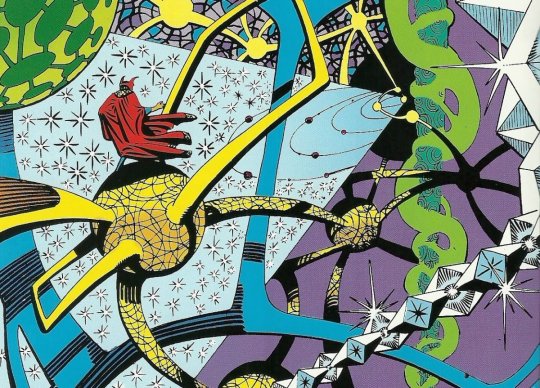
The creative high point of this era is the famous Eternity Saga. Spanning Strange Tales 130-146, it is sometime referred to as the first proper “graphic novel” story arc in superhero comics. The epic started prior to, and overlapped with the overshadowing Galactus Trilogy in Fantastic Four, but is far longer.
In this story, Ditko introduced Eternity, one of the first cosmic entities of the Marvel Universe. A pantheon that would be added to over the years and later used to epic effect by folks like Jim Starlin, Dan Abnett, and Andy Lanning.
The story is about the entanglements of Strange, Eternity, Dormammu, and Baron Mordo.

If you’d like to read all of Lee and Ditko’s magical tales, you have a few options.
There is a hardcover omnibus collecting the entirety of Strange Tales 110-111, 114-146 together in one tome. It is a rather thin one compared to Marvel’s other releases so as to isolate Ditko’s work.
The same material has also been collected variously in hardcover masterworks, black and white paperback essentials, Doctor Strange Classic single issue reprints, etc. Some of these may be out of print and expensive online due to high demand.
All of the above information has been primarily sourced from good olde Wikipedia (a totally legitimate source), the dark recesses of my own brain, the Marvel Wikia, this Polygon article, and most importantly Neilalien.com which is a fantastic Doctor Strange fansite.
#Vincent Faust#doctor strange#dr strange#dr. strange#doc strange#stan lee#steve ditko#ditko#ditko doctor strange#steve ditko doctor strange#supernatural#magic#marvel#marvel comics#roy thomas#comics#comicbooks#comic books#comic art#comics history#roger stern#marshall rogers
13 notes
·
View notes
Text
“90s Comics Sucked”

#Vincent Faust#1990s#1990s comics#90s comics#comics#comicbooks#comic books#hellblazer#sandman#starman#x-men#transmetropolitan#concrete#hitman#madman#maus#hellboy#stormwatch#kingdom come#avengers#black panther#bone#astro city#doom patrol#sin city#shade#harbinger#valiant#icon#milestone
8 notes
·
View notes
Text
CCF for August 4, 2017 - Avengers Vol 1 56

Rip Bucky. Rest in pieces.
Other Submissions:

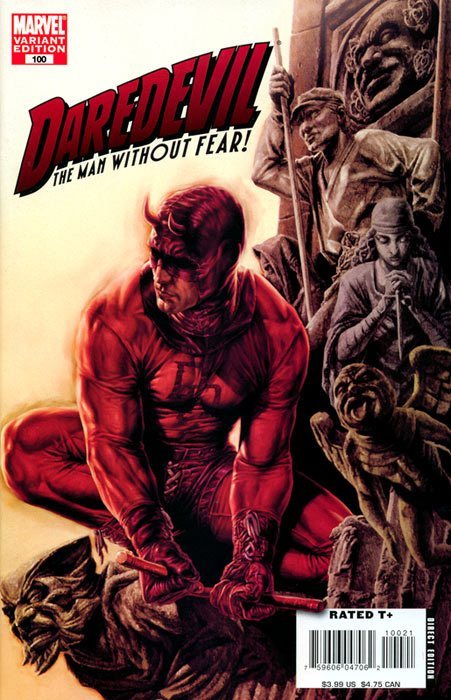

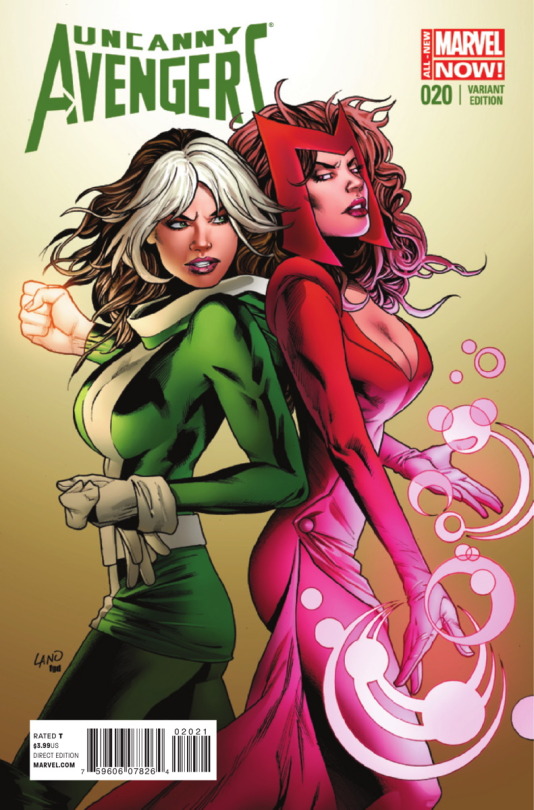
#CCF#avengers#john buscema#captain america#bucky#bucky barnes#batman#batman adventures#paul dini#bruce timm#timmverse#comics art#comic art#comics covers#comic covers#uncanny avengers#rogue#scarlet witch#daredevil#lee bermejo
4 notes
·
View notes
Text
CCF for July 28, 2017 - Detective Comics Vol 1 596

Kinky...
Other Submissions:




#CCF#detective comics#batman#flash#flash rebirth#barry allen#ethan van sciver#paolo rivera#daredevil#x-men#the flash#dc#dc comics#marvel#marvel comics#comics#comic books#comicbooks#comics art#comic art#comics covers#comic covers
4 notes
·
View notes
Text
CCF for July 21, 2017 - JSA 73

Warner Bros. better do this iconic character justice. Their track record still isn’t so strong. Alex Ross knows how to respect Captain Marvel though.
Other Submissions:





#CCF#shazam#captain marvel#day of vengeance#jsa#justice society#justice society of america#alex ross#alex ross art#comics art#comic art#comics covers#comic covers#flash#wally west#the flash#alan davis#inhumans#jae lee#x-men legacy#x-men#legion#david haller#avengers#john buscema#john byrne#spider-man#symbiote#symbiote suit#marvel
3 notes
·
View notes
Text
A Rambling Chronicle of Marvel’s Western Comics
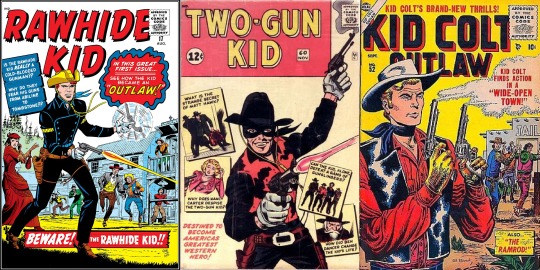
By Vincent Faust - November 27, 2018
Marvel Comics is the most prolific comic book publisher of the Western genre. Despite their near ubiquity in today’s culture with billion dollar box office receipts, even their diehard fans may not know this part of their past.
I may be missing a few scattered things, but by my count Marvel has published 1,192 issues of Western comics through their history. Marvel had published Western stories from their very beginnings with the Masked Raider in 1939′s Marvel (Mystery) Comics 1-12. Though the genre didn't explode until the late 1940s following the war, while superheroes were declining. Timely (Marvel’s name at the time) launched 7 western titles in 1948.
The "Big Three" of Marvel westerns are Kid Colt Outlaw, Rawhide Kid, and Two-Gun Kid. Each lasting an impressive 229, 151, and 136 issues respectively.
The star artist of Kid Colt was Jack Keller. Who drew most of the character's stories from 1953-1967. An impressive run. Some have argued he has the honor of drawing the most individual stories for one specific Marvel character. Many of these books had 3-5 short stories per issue, so I wouldn't argue against that. If we only count full issue stories, I'm not sure who would take that title. Probably Mark Bagley for Spider-Man, combining his lengthy 1990s run on Amazing and his history making 2000s run with Bendis on Ultimate.
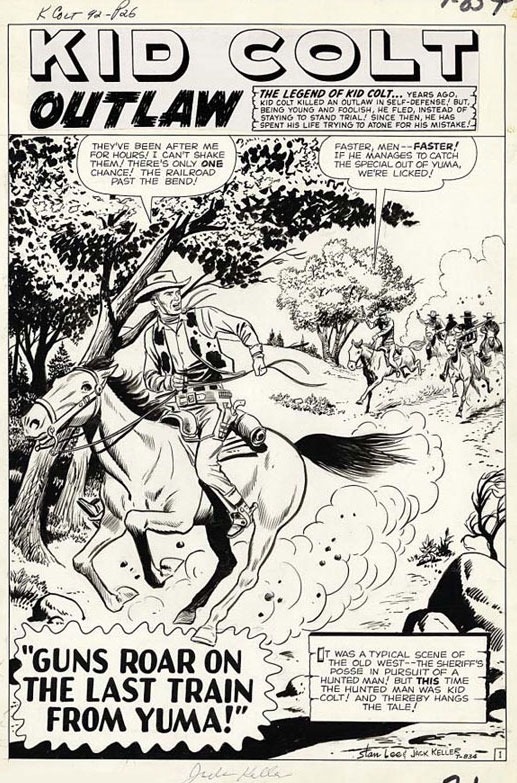
In 1960, right before the Fantastic Four, Stan Lee and Jack Kirby reinvented Rawhide Kid. After a publishing hiatus the title was brought back with issue 17. The character was now Jonathan Clay and his costume changed. Over two and a half years, their run was revered as the cream of the crop in a waning genre as their own superheroes began to explode.

As Kirby was needed more and more on the superhero titles selling like hotcakes, a tiny run by Jack Davis followed. Davis was an EC Comics legend who took a pit stop at Marvel before becoming even more of a legend at Mad Magazine. Unfortunately, practically the only classic Marvel Westerns to be reprinted in collections is this span of Rawhide Kid. With issues 17-35 reprinted across two hardcover Marvel Masterworks.
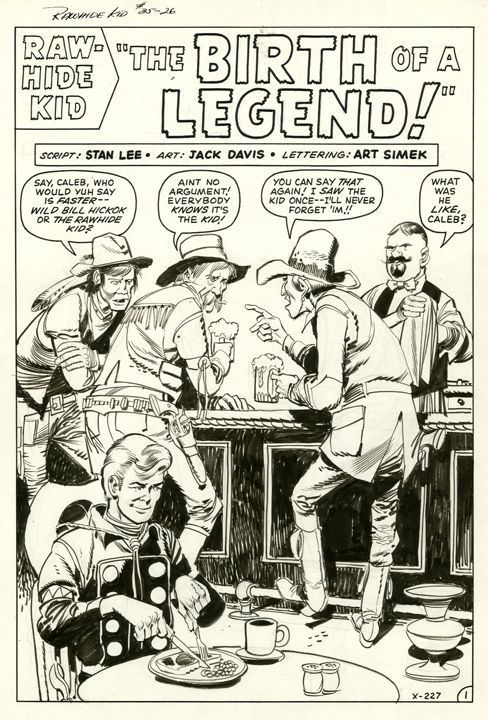
Here is Stan Lee talking to Jack Davis and fellow EC/Mad/minor Marvel contributor Harvey Kurtzman. For Marvel, the legendary Kurtzman did 150 episodes of a one-page filler strip titled Hey Look! from 1946 to 1949.
youtube
Especially as Marvel was finally able to publish more titles, Stan Lee's efforts were being stretched too thin as well. So, Rawhide Kid was handed over to his younger brother Larry Lieber to write and draw. Which he did for almost a decade, to minor acclaim from genre fans. Sounds very reminiscent of the hidden gem Gary Friedrich/Dick Ayers/John Severin run on Sgt. Fury and His Howling Commandos.
"I don't remember why I wanted to do it, particularly. I think I wanted a little more freedom. I didn't do enough of the superheroes to know whether I'd like them. What I didn't prefer was the style that was developing. It didn't appeal to me. Maybe there was just too much humor in it, or too much something. I remember, at the time, I wanted to make everything serious. I didn't want to give a light tone to it. When I did Rawhide Kid, I wanted people to cry as if they were watching High Noon or something." - Larry Lieber
Lee and Kirby also reinvented Two-Gun Kid for the early 60s, but didn't stick around as long on that one.
Other artists who made a mark on Marvel's western titles include Fred Kida, a notable Golden Age Japanese-American artist known primarily for Airboy. Also Russ Heath, who passed away only recently, and the frequent collaborators John Severin and Dick Ayers. Most of these artists were also prolific in the war genre. The genre is also to thank for the introduction of Herb Trimpe, who would go on to become the definitive Hulk artist.
The true star of the show though was one Joe Maneely. Who Stan considered his best artist before Jack Kirby returned in 1958. The Philadelphia native was skilled and fast, pumping out tons of westerns as well as the Black Knight and Yellow Claw titles, which retroactively tie his work to Marvel continuity. Unlike Kirby, Keller, and Lieber he was not particularly linked to one western title, but his most consistent would be Ringo Kid.
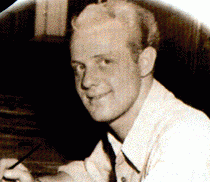
Meanwhile, outside of the genre one of Stan Lee's other top artists was Matt Baker. Considered to be the first African American professional in the field. Also there are reliable reports from friends and family that Baker may have been a gay man. He was one of the primary innovators of the "good girl" art style on Fox Feature Syndicate’s Phantom Lady and countless romance titles. Another milestone was drawing arguably the first graphic novel - It Rhymes with Lust.
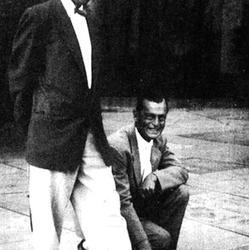
Due to some business factors in and out of publisher Martin Goodman’s control, Marvel (at this point known as Atlas Comics) nearly imploded in 1957. The bullpen was completely disbanded, leaving Stan Lee in an empty office. They went from regularly publishing almost 70 titles to only 16. Many of which were filled with inventory stories and reprints as long as Stan could manage not paying freelancers. This situation was further complicated by their new distributor having way too close of a relationship with market share leader National (now DC Comics).
Joe Maneely stepped in front of a train in 1958 at only the age of 32. It may have been a suicide. Matt Baker died of a heart attack in 1959 at 37. As stated above, Jack Kirby comes back to Marvel right around that time and Steve Ditko was quickly growing as an artist. It's tragic how close these two masters were to being on the ground floor of the Marvel Universe as we know it today. What heroes could Maneely and Baker have drawn or created?
The 1970s sees lots of reprints of classic genre comics. An exception is the original title Gunhawks (though an unrelated The Gunhawk title predated it). Though only lasting seven issues, Gunhawks has an interesting distinction. Originally starring Kid Cassidy and Reno Jones, a good ol’ plantation boy and his buddy slave. Who fought willingly for the Confederacy because some Yankees kidnapped his girlfriend. That makes sense... In the sixth issue, Cassidy is shot and killed. The finale was technically retitled to Reno Jones, Gunhawk. Making that 1973 comic book only the second at Marvel to be named after a Black protagonist, following Luke Cage. Black Panther had ongoing adventures, but had taken over the anthology title Jungle Action and wouldn’t get his own series until later. DC lagged behind Marvel in this regard.
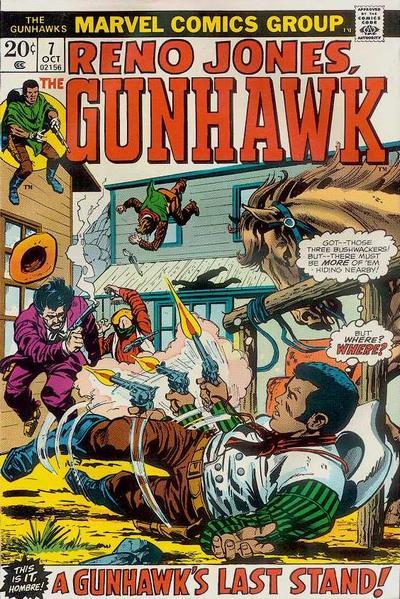
In 1979 the western genre at Marvel was basically declared dead, with Rawhide Kid and Kid Colt finally canceled. The latter after over 30 years of continuous publication. Two Gun Kid had been canceled two years earlier. Though for a few years already, almost all of Marvel's westerns (and war books) had been turned into reprint titles.
Of those aforementioned 1,192 issues, 1,146 of them are from 1979 or earlier. Leaving less than 50 across the last 40 years.
A 1980 tryout issue with a new character (and a Frank Miller cover) goes nowhere.
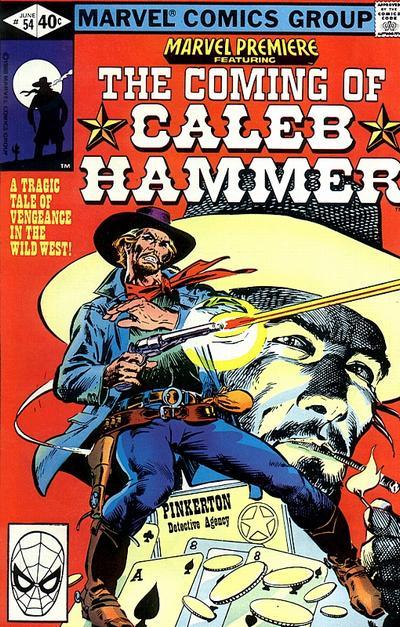
A 1985 miniseries by genre veterans Trimpe and Severin depicts the Rawhide Kid now as a middle aged man, as the West is in its final days. It is kind of depressing.

Backpedaling a bit. As the Marvel superheroes dominate, the western heroes occasionally make crazy guest appearances through the means of time travel. Most notably the Two-Gun Kid becomes an all-but-official member of the Avengers and a close friend of Hawkeye. He gets tied up with time travel generally for years to follow. Later becoming a She-Hulk supporting character and Avengers Initiative leader circa Civil War

With that cover, let's now take another aside to untangle Ghost Rider. Ghost Rider is not originally a Marvel property. The vigilante was created by Gardner Fox (Justice League of America) and Dick Ayers for Magazine Enterprises in 1949 as a horror themed western character. The feature spent time as a backup in Tim Holt and eventually broke out into its own short lived title.
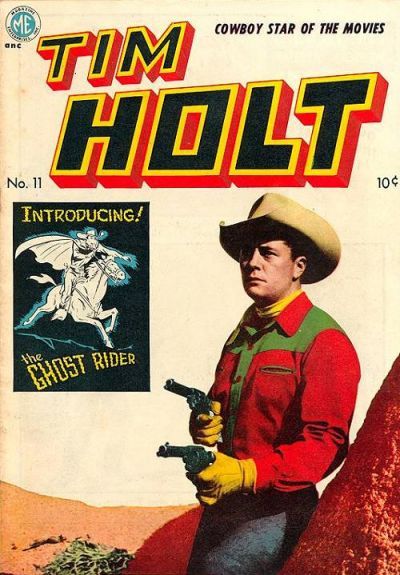
Magazine Enterprises went kapoof alongside the slump in the industry around the implementation of the Comics Code Authority in 1954. The regulation agency set up by industry leaders to avoid government intrusion following moral panic. The over-cautious guidelines severely neutered the crime and horror genres, while superheroes were already dormant, gutting many publishers. The Ghost Rider trademark expired. Marvel picked it up in 1967 for a series drawn by original creator Dick Ayers. Motivated in equal toxic parts by Martin Goodman's obsession with securing trademarks (practically every character Stan Lee created can be traced to an earlier one) and then rising writer Roy Thomas's history nerd leanings.

Obviously the name would be repurposed for the more recognizable Johnny Blaze in 1972. Marvel retroactively renamed Carter Slade as the Phantom Rider. The modern demonic versions of Ghost Rider do rarely touch on western themes. Johnny spent some time as a nomad and Garth Ennis brought in some western connections to expand the GR lore.
The western genre is basically passed over through the whole 1990s.
In 2000, John Ostrander and Leonardo Manco come around for a miniseries integrating all the Marvel western heroes together. Followed by a 2002 sequel. With revelations and deaths. The kind of lore retconning series that tickles the fancy of comic history nerds like yours truly. Ostrander also did Justice League: Incarnations around this time, tracing through the history of the JLA.

2003 comes around and it all that heavy lifting revitalization goes in the toilet. Ron Zimmerman writes a Marvel Max Rawhide Kid series. Zimmerman is some kind of comedy writer and Howard Stern regular. Well, within comics he wrote this and the god awful Ultimate Adventures - the only wholly original Ultimate Universe book, a Batman and Robin parody that was part of the U-Decide bet with Marville and PAD's Captain Marvel.
Marvel Max was a new imprint established in the early 2000s to break away from the aforementioned Comics Code and tell more daring, mature stories. Occasionally this resulted in gold like Jessica Jones. However, most of the time it was cringe inducing dreck.
So what's so bad about Rawhide Kid Max? He's now gay. Umm...OK, as long as it's handled well, maybe? Nope, constant cringey sexual innuendos which border on the protagonist coming off as a sexual predator. Some idiot gave it a sequel years later too.
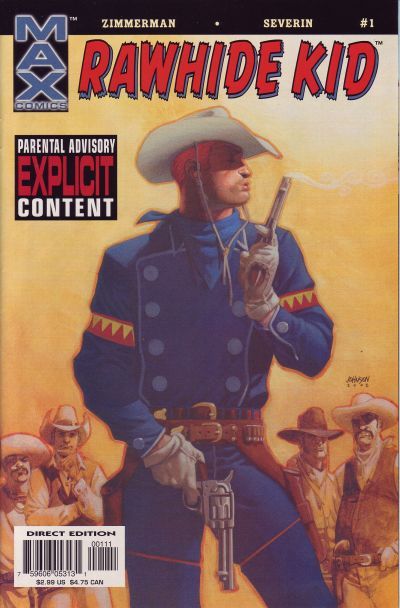
Since then, we've gotten a bunch of one-shots in 2006, a weird Andy Diggle miniseries in 2012, and then the surprisingly great Marvel 1872 from Gerry Duggan during the patchwork reality crossover event Secret Wars. Which set up the Red Wolf series which was doomed by bad optics surrounding the writer and Marvel's spaghetti on the wall strategy of the time.
One of those 2006 one-shots ended up being legend Marshall Rogers's final published work. He and longtime collaborator Steve Englehart did it while waiting for DC to greenlight Dark Detective III, the second spiritual sequel to their influential 1970s run on Batman.
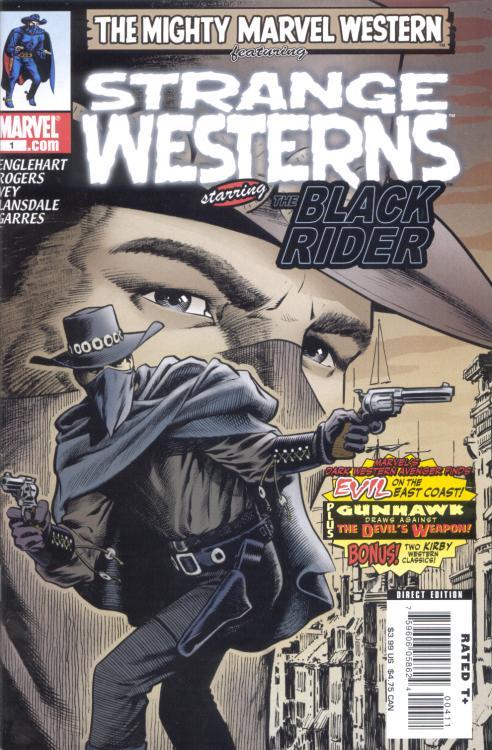
Here’s hoping we get to see some of these legendary heroes on the trail once more. At the very least we will get another tiny snippet in 2019 with a Gunhawks one-shot being brought back in celebration of Marvel’s 80th anniversary. Written by crime comics duo David and Maria Lapham.
This concludes a rambling chronicle of Marvel's history with the western genre and considerable tangents touching more generally on the history of Marvel and the comic book industry.
5 notes
·
View notes
Text
Marvel's Captain Marvel: A Legacy of Failed Relaunches
This piece is about the history of the Captain Marvel name in superhero comic books. First we have to start with the originator, then how it was shut down, then we can get to how it was stolen and how it's been handled since. I will not be getting in to Miracleman/Marvelman, since that is a whole other layer of convoluted.
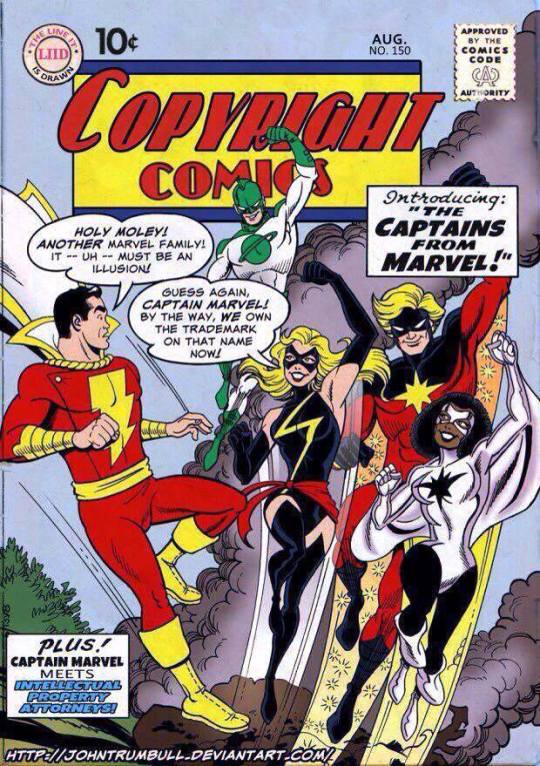
Fawcett Publications was a publisher of magazines in the 1920s and 30s. They wanted to break into the comic book business after seeing the insane success of Superman starting in 1938. So in 1940 writer Bill Parker and artist CC Beck came up with a superhero for this purpose. The character was to be called Captain Thunder and debut in Flash Comics #1. However, All-American Periodicals beat them to the punch with their own Flash Comics #1 with a cover date of January 1940, debuting the Flash, Hawkman, and other characters. So Fawcett switched the title to Thrill Comics. Which they couldn't use either when Standard/Nedor launched Thrilling Comics #1 with a cover date of February 1940. I guess even the "ing" was too close for trademark comfort. January 1940 also saw the first issue of Fiction House's Jungle Comics, which had a minor backup feature starring Captain Terry Thunder. So when their character was finally unveiled to the public, he was Captain Marvel and appearing in WHIZ Comics #2.
The parallels to Superman were there off the bat and intentional. The first cover features Captain Marvel throwing a car, in reference to the iconic Action Comics #1, but one-upping it. Their powers, costumes, and adventures were somewhat similar. Captain Marvel arguably improved on the Superman formula. Instead of the grown, nerdy Clark Kent, Captain Marvel's secret identity was the child Billy Batson. Rather than looking up to Superman, kids could put their selves in Billy Batson's shoes. The art of CC Beck and others was also more cartoony and the stories more outlandish and fun. While Superman was dealing with corrupt politicians and domestic abusers, Captain Marvel was fighting the moon and hanging out with anthropomorphic tigers.
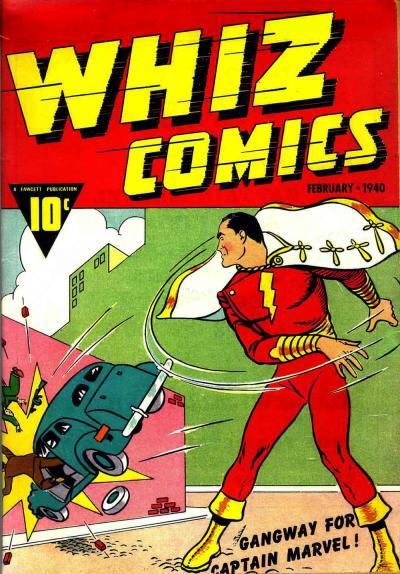
Captain Marvel replicated the success of Superman, and for a while even outsold the poster boy of comic books. The character's success led to Fawcett creating a whole line of comics and superheroes like Bulletman, Spy Smasher, Minute-Man, Ibis the Invincible and so on in the titles Nickel Comics, Wow Comics, Master Comics, etc. Captain Marvel started multiplying himself with spinoff characters Captain Marvel Jr. and Mary Marvel (before DC created Supergirl). The publisher experienced great success through the 1940s.
This success bothered some people, namely competitor National (today's DC Comics). They had success earlier shutting down Fox Feature Syndicate's character Wonder Man for being too close to Superman. They even did the same thing to Fawcett with their character Master Man. Starting in 1941 National took Fawcett to court over Captain Marvel. The lawsuit and all its subsequent appeals lasted all the way to 1951. Meanwhile Superman was ripping off elements of Captain Marvel along the way, like starting to actually fly, Lex Luthor becoming a bald mad scientist (like Dr. Sivana), and introducing the adventures of Superboy akin to Captain Marvel Jr. The long legal struggle and the waning superhero popularity of the 1950s led to Fawcett giving up on the case and shutting down their entire comics line in 1953.
Of course, having won, DC took the opportunity to pull over Fawcett's talent and put them to work on Superman. DC then ended up licensing Fawcett's characters in the 1970s. Captain Marvel has been fully integrated to the DC Universe through the years, for better or worse.
There is just one ironic hiccup though. While Captain Marvel lay dormant in the 1960s, the trademark lapsed. Another comic publisher by the name of Timely Comics had went through a few eras and name changes to Atlas Comics and then to Marvel Comics. Marvel was becoming a major force in the early 1960s thanks to Stan Lee, Jack Kirby, and Steve Ditko. Publisher Martin Goodman demanded that they snatch up the trademark to Captain Marvel. Fitting I suppose given the name of the company.
So in December 1967 Marvel's version of Captain Marvel debuted in Marvel Super-Heroes 12. Rather than a Superman-like character, this version was Mar-Vell, an alien warrior who was tasked to spy on Earth but then decided to protect humanity. The stories were light science fiction fare.
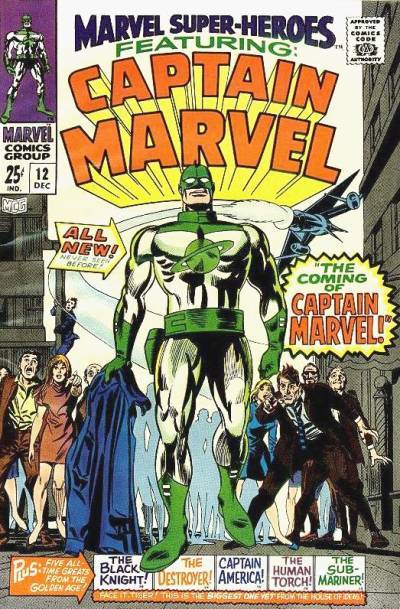
This Captain Marvel would not become a sales juggernaut like Fawcett's. Marvel has to maintain their right to the trademark at least every two years though. So this has lead to dozens of relaunches and different characters under the Captain Marvel name.
This is their legacy of failure.
After two appearances in Marvel Super-Heroes (12-13) Captain Marvel received his own self-titled comic in May 1968. From the first appearance through the fourth issue of the series, Gene Colan drew the character and Roy Thomas wrote him. Then not even a year in new creative team Arnold Drake and Don Heck hop on. Other creators like Gary Friedrich, Dick Ayers, and Archie Goodwin rotate through. The original green and white costume has a simplistic design that has become retroactively classic, but is really not too special.
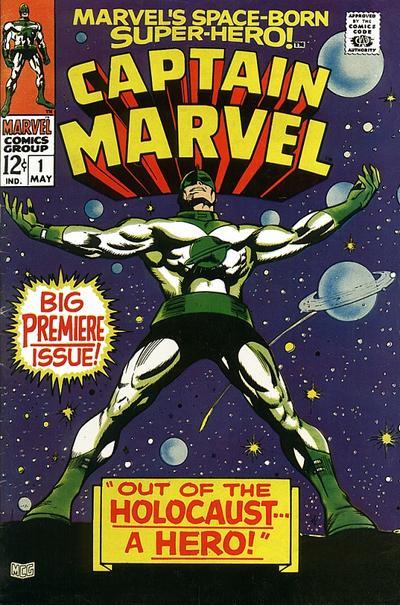
With issue 17 in October 1969, Roy Thomas comes back and is joined this time by Gil Kane. The pair introduce a new costume and the unique dynamic of Captain Marvel playing switcheroo with perennial sidekick Rick Jones. The quality of the book vastly improves, but it only gets the chance to show it off for three issues.
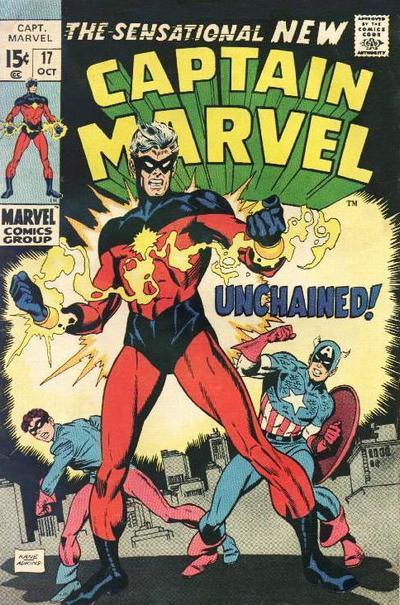
After a six month hiatus, Captain Marvel resumes with issue 20 and the same creative team from before. This time they only get to pump out two issues. The book will now be bimonthly for the most part from here on out.
The character would feature prominently in the classic Kree/Skrull War storyline in Avengers, also written by Roy Thomas. This kept him relevant through 1971 even without a book.
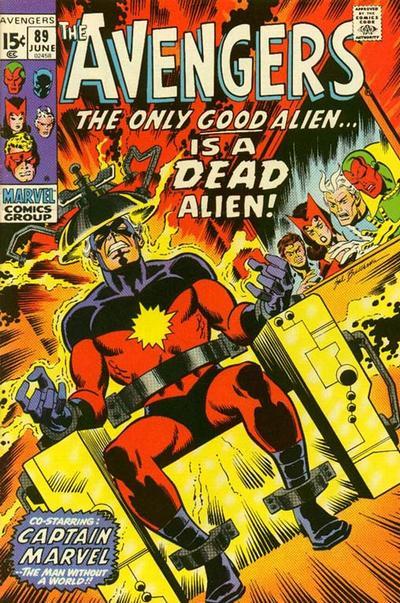
And Mar-Vell is back again two years later in 1972 (recall the trademark rules). This time we have three uninspired issues written by three different writers. The only notable piece here is that they're drawn by Wayne Boring. Who was one of the definitive Superman artists of the 1940s and 50s in comic books and strips. In 1967 DC kicked him out, as they had done with most of their iconic Golden Age artists. Super fan and historian Roy Thomas hired him to do a few jobs for Marvel in the 70s. It's cool to see, but his style honestly was out of date by this point. The irony of these past two relaunches is that both returning issues use the cover text "the hero who wouldn't die!" The irony will become evident in a bit.
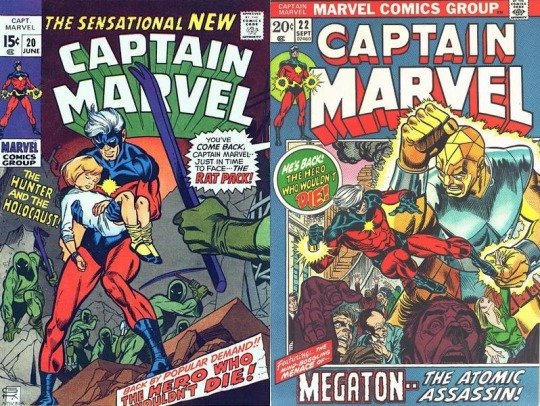
By this point DC has licensed the original Fawcett Captain Marvel. Due to Marvel's trademark usage, DC has to title the comic Shazam (the catchphrase Billy Batson uses to transform into the hero). Shazam runs from 1973 through 1978 and then the character moves to anthology backups. Superman even introduces the Big Red Cheese on the cover of the first issue. Within the pages of the comic, the character is still allowed to be called Captain Marvel. This alleged confusion has caused anxiety over the years for DC and with the New 52 reboot in 2011 they tried to officially change the icon's name to Shazam.
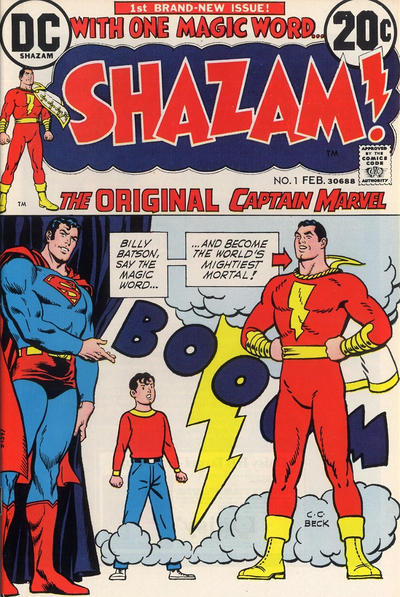
With issue 25 in 1973 Captain Marvel finally becomes a must-read comic when a young Jim Starlin jumps on board as artist. He had previously written and drawn fill-in issues of Iron Man that introduced the characters Thanos and Drax the Destroyer. He brought those characters with him and began writing as well, giving fans the iconic Thanos War arc. Starlin sticks around for less than a year. His final issue is 34, where Mar-Vell fights Nitro and the infamous cover text describes him as "the man who killed Captain Marvel." It's originally just supposed to be a sensational lie as is the tradition.
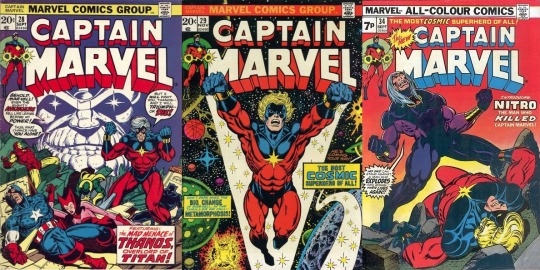
With Starlin gone, Captain Marvel still continues to issue 62 in 1979. Al Milgrom and Pat Broderick draw most of this run. Steve Englehart, Scott Edelman, and Doug Moench handle the writing. Nothing truly memorable or relevant happened, though by this point there were Mar-Vell fans who surely enjoyed it.
Supporting character Carol Danvers also got superpowers and got a spinoff title that ran two years. Mostly written by Chris Claremont. Ms. Marvel would have her own too-late creative reinvention in issue 20 thanks to artist Dave Cockrum. This book was arguably better than the book it spun out of at this point. Carol Danvers will become important again in this saga, but for the time being Claremont pulls her way to be an occasional presence in his vast X-Men run.
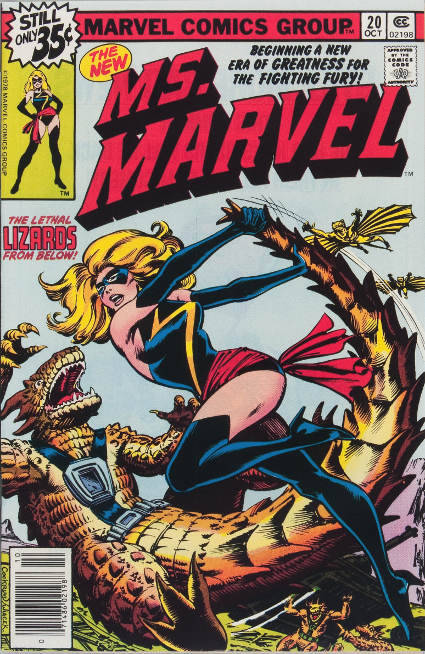
Captain Marvel was cancelled prematurely, so Marvel launched a new volume of Marvel Spotlight to pump out inventory issues. Captain Marvel appeared in Marvel Spotlight 1-4, and 8. Of curiosity is that Steve Ditko and Frank Miller drew the last two issues.
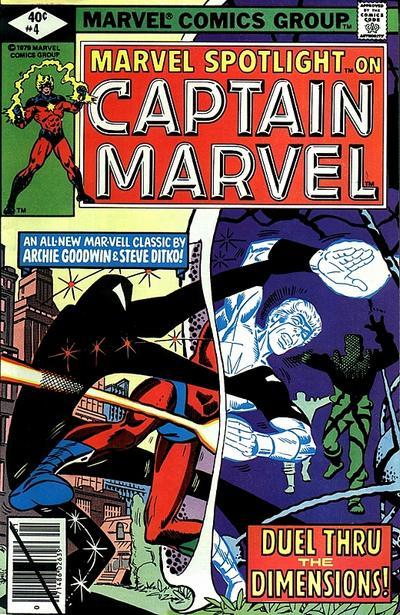
Outside of a few appearances, Mar-Vell doesn't make a major appearance between September 1980 and April 1982. When Jim Starlin was offered to write and draw the first installment of the Marvel Graphic Novel series and kill off a major character. One can presume he wasn't allowed to choose Spider-Man. He went with Captain Marvel, following up from his final issue on the series and revealing that the fight with Nitro gave him cancer. He died surrounded by all his fellow heroes and the book is a genuine emotional classic. It solidifies Mar-Vell as a legend, even if his original series never truly got him to deserve that reputation.
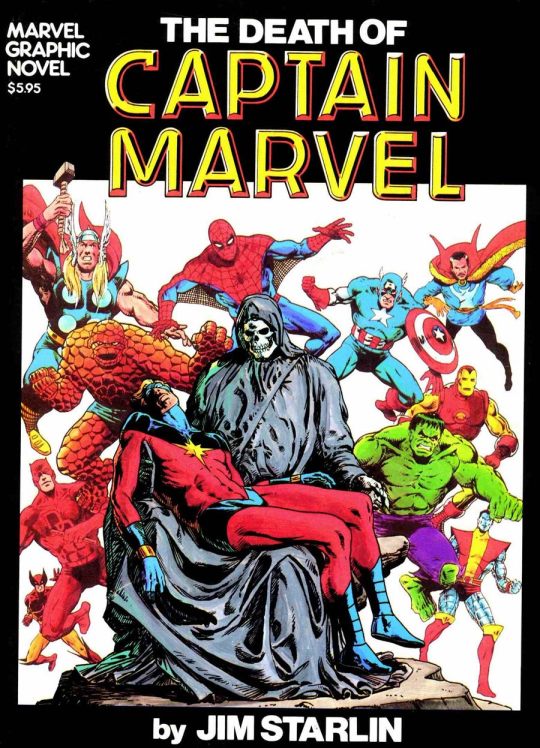
Mar-Vell would be featured in a reprint series titled The Life of Captain Marvel in 1985 focusing on the Starlin run. A three issue flashback series to his green and white era was published in 1997.
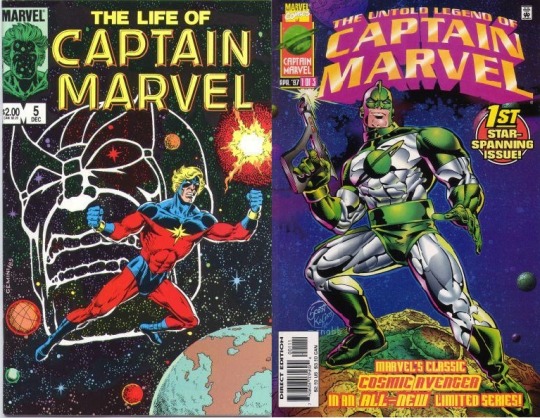
They need to maintain the trademark though, right? Enter Monica Rambeau in Amazing Spider-Man Annual #16 the same year. Her connection to Mar-Vell was nonexistent, but she took on the Captain Marvel name regardless. Creator Roger Stern carried her over to his legendary Avengers run and she even lead the team for a period. Monica has had tons of memorable appearances since, such as the brilliant Nextwave: Agents of HATE.
Monica would receive solo one-shots in 1989 and 1994. Both by the creative team of Dwayne McDuffie and M.D. Bright.
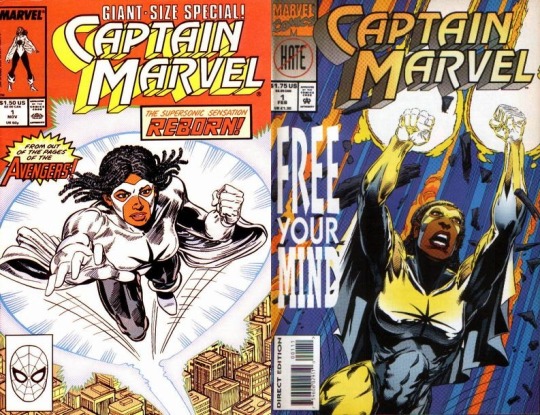
The third Marvel character to go by Captain Marvel was Genis-Vell. Originally introduced in Silver Surfer Annual #6 as Legacy, Genis is Mar-Vell's bastard child. Genis gets his father's Nega Bands and even is linked to Rick Jones. He got his own series written by Fabian Nicieza in late 1995 that was cancelled prematurely after six issues. In Avengers Unplugged #5 Genis officially takes the Captain Marvel name from Monica, who then suffers through several code names over the years.
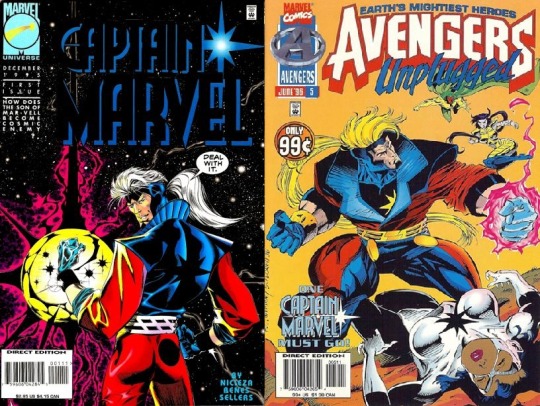
After disappearing for about two years, Genis pops up again prominently in the Avengers Forever maxiseries. This launched a 2000 series written by Peter David and drawn by ChrissCross. The series was a critical darling and cult hit, but sales weren't perfect.
To try and boost sales, the book was relaunched in 2002 as part of the U-Decide Campaign. Which was a (marketing ploy) bet between David, Bill Jemas, and Joe Quesada. Fans helped to decide which of three books would survive. It helps that the other two books (Marville and Ultimate Adventures) were absolute trash, but Captain Marvel handily won. It lasted another 25 issues to bring the entire run to 60 issues. During the run, the fourth Captain Marvel Phyla-Vell is introduced as Genis' sister/clone. She uses the name briefly and then becomes Quasar and then Martyr in other stories. Genis eventually goes crazy, then dies.

In 2008 as part of the Secret Invasion crossover, Mar-Vell seems to come back to life in a self-titled miniseries. However, it's revealed that this character is a Skrull with fake memories.
The Skrull fake dies, but is able to pass on his wishes to the Kree hero Noh-Varr. Who was previously known as Marvel Boy, but then becomes Captain Marvel during the Dark Reign era. After discovering he's being manipulated, he abandons the Dark Avengers and takes on the Protector identity.
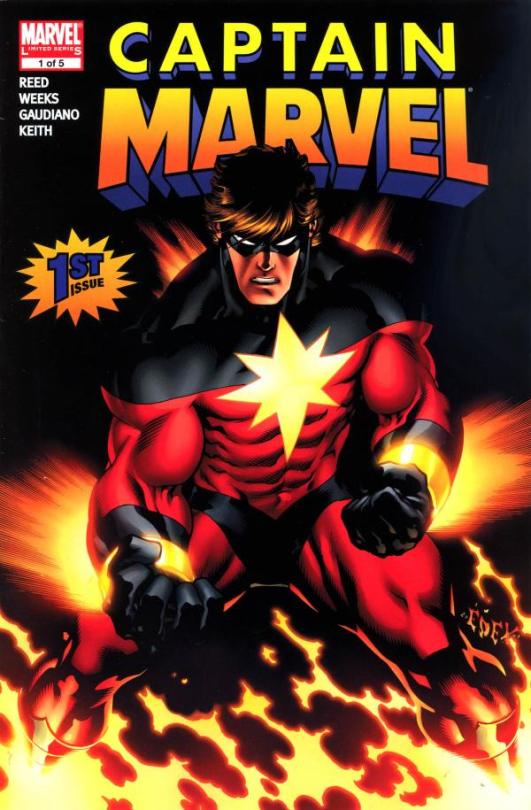
While the Avengers stock is rising in the 2000s thanks to Brian Michael Bendis, Carol Danvers is back as Ms. Marvel and her mission is to become the prominent hero she thinks she can be. To really promote her, in 2012 Marvel gives her the Captain Marvel name, redesigns her costume, and launches a new title. Kelly Sue DeConnick will shepard the character for the next few years. This series only lasts 17 issues.
By 2012 Marvel has now entered their relaunch trigger happy era. So in 2014 Captain Marvel is relaunched while keeping the same writer. This volume is even shorter at 15 issues.
As a tie-in to the alternate reality event Secret Wars in 2015, Carol Danvers gets her own miniseries still by KSD.
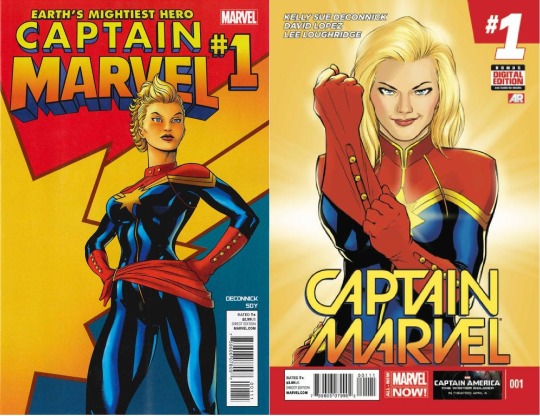
Coming out of Secret Wars, Captain Marvel gets another volume. This one lasts only 10 issues. Marvel brings in TV writers Tara Butters and Michele Fazekas. They leave halfway through and are replaced by Christos and Ruth Gage. The character is significantly entangled in the divisive crossover event Civil War II around this era.
In 2017 another relaunch is due and Carol gets the slight title change to The Mighty Captain Marvel. Prose writer Margaret Stohl is the writer. This series lasts nine issues before being renumbered/retitled as part of Marvel's Legacy initiative. Still with Stohl, renumbered for only five issues.
A soon to be released one-shot tie-in to Infinity Countdown promises Carol adventuring with Monica and possibly Mar-Vell. Marvel has been subtly teasing Mar-Vell's genuine return again recently.
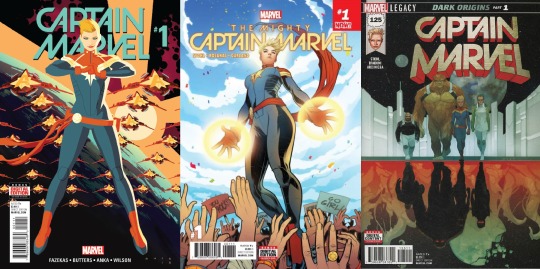
With a Captain Marvel movie starring Carol Danvers just around the corner, Marvel obviously needs to relaunch again (SIGH). July 2018 will bring The Life of Captain Marvel #1. Still written by Stohl, the series promises to retell Carol Danver's origin. So maybe they'll decide to relaunch it again after the origin arc is over.
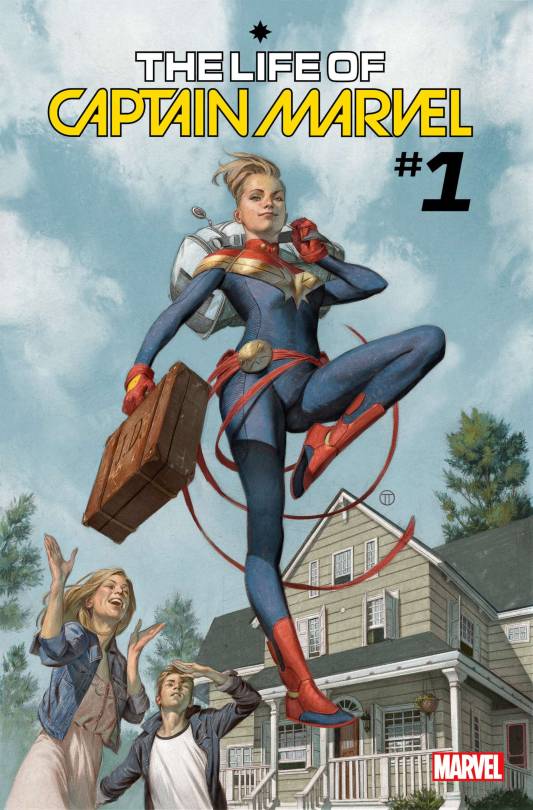
It's unclear whether DC would have been able to quickly grab the trademark back in the possibly free periods of 1984, 1987, 1992, 1998, and 2006. I don't know if the publication of collected editions fulfills the trademark requirements. If so, Masterworks and other collections could tick off some of those possible open spots.
To summarize, here are all of Marvel's Captain Marvel titles and relaunches:
Mar-Vell Marvel Super-Heroes 12-13 (December 1967-March 1968) Captain Marvel Vol 1 1-19 (May 1968-December 1969) Captain Marvel Vol 1 20-21 (June-August 1970) Captain Marvel Vol 1 22-62 (September 1972-May 1979) Marvel Spotlight 1-4, 8 (July 1979-September 1980) Death of Captain Marvel (April 1982) Life of Captain Marvel Vol 1 1-5 (August-December 1985) Untold Legend of Captain Marvel 1-3 (April-June 1997)
Monica Rambeau: Captain Marvel Vol 2 1 (November 1989) Captain Marvel Vol 2 1/2 (February 1994)
Genis-Vell: Captain Marvel Vol 3 1-6 (December 1995-May 1996) Captain Marvel Vol 4 0-35 (November 1999-October 2002) Captain Marvel Vol 5 1-25 (December 2002-September 2004)
Skrull Fake: Captain Marvel Vol 6 1-5 (January-June 2008)
Carol Danvers: Captain Marvel Vol 7 1-17 (September 2012-January 2014) Captain Marvel Vol 8 1-15 (May 2014-July 2015) Captain Marvel and the Carol Corps 1-4 (August-November 2015) Captain Marvel Vol 9 1-10 (March 2016-January 2017) Mighty Captain Marvel 0-9 (February-November 2017) Captain Marvel Vol 1 125-129 (December 2017-April 2018) Life of Captain Marvel Vol 2 1-? (September 2018-?)
*Dates used are cover dates.
#captain marvel#carol danvers#shazam#mar-vell#kree#genis-vell#monica rambeau#photon#pulsar#marvel#marvel comics#comics#comicbooks#comic books#dc#dc comics
54 notes
·
View notes
Text
What Happened Between the Spider-Man Clone Saga and the 1999 Next Chapter Relaunch?
DeFalco and DeMatteis simply switched books at the end of the Clone Saga, so DeMatteis was back on Spectacular (241-258). Just over five years after his legendary run on the book involving the downward spiral of Harry Osborn. Kraven's second son takes on his father's mantle. Chameleon does some stuff. Luke Ross on art. Clone Saga is such an infamous and giant storyline. Next Chapter (1999) is likewise a super controversial and mostly hated relaunch. The stuff in the middle is nearly two years of wasteland comics that no one ever talks about positively or negatively. It was mostly the same creators from the end of the Clone Saga limping around until a final crossover story resolves some lingering two year old plotlines and ends Marvel's at that point longest running title.

Tom DeFalco writes Amazing during this period (419-439). With a chunk of it drawn by Steve Skroce, so your mileage may vary if you dig his art. There's an X-Man appearance, which Skroce had co-created. Doc Ock comes back alive after dying in the Clone Saga. The Carnage symbiote gets attached to Silver Surfer.

Here's some Skroce art (of course the best example I could find is from the very end of the Clone Saga). He's also known for the Wolverine Blood Debt arc, which I guess was a huge deal in 2000 around the milestone of Wolverine 150.


DeFalco and DeMatteis simply switched books at the end of the Clone Saga, so DeMatteis was back on Spectacular (241-258). Just over five years after his legendary run on the book involving the downward spiral of Harry Osborn. Kraven's second son takes on his father's mantle. Chameleon does some stuff. Luke Ross on art.
Here’s the very next chronological issue of Spidey after the Clone Saga closes (collected alongside it).


Howard Mackie and John Romita Jr. continue on (adjectiveless) Spider-Man (76-95). They pull out Juggernaut again for a callback to JRJR's first run way back with Roger Stern. Morbius arc, Shocker arc, Mackie essentially retconning all the 90s Ghost Rider from after he left that title.
Also this title gets a fake "adjective" around this time. Becoming Peter Parker: Spider-Man with its final Clone Saga tie-in through its cancellation. Of course the 1999 relaunch would include Peter Parker Spider-Man as one of its two books, with Romita staying on as artist. The Marvel wiki refers to it as PPSM Vol 2. Spectacular Spider-Man Vol 1 also used the Peter Parker prefix for its first 133 issues.

At the end of Ghost Rider's 1990 series Danny Ketch becomes a Lord of Hell. But it got cancelled and Marvel wouldn't even put out the final issue. Only one issue referenced that status quo (Werewolf by Night). Then this single issue of Spider-Man completely ignored it and also ignored other major GR plot points. After this, a Ghost Rider wouldn't appear at all again for 3 years. When Johnny Blaze was suddenly back in the role with no mention of Danny, a change that has still never been explained to this day. Danny Ketch wouldn't appear again after this Spider-Man issue for almost 10 years. The final issue of his 1990 series was finally published 9 years late around the time of the Nic Cage film.

Sensational Spider-Man is written by Todd DeZago and brilliantly drawn by Mike Wieringo (12-31). The era kicks off with a fun Savage Land story which even got its own 90s era tiny trade. A "Sensational Spider-Man by DeZago and Wieringo" trade recently collected a lot of this, double dipping a bit with Clone Saga with 7-24.
This arc was published right before Ka-Zar's 1997 Mark Waid and Andy Kubert series was launched.

For fans of Ringo from Fantastic Four or his later Spidey work, this can be found relatively cheap. The first few Clone Saga-entrenched issues are mostly standalone besides some ongoing subplots. Only one issue in the trade won't make much sense.

There are a few major crossovers around this era.
Spider-Hunt has Spider-Man framed for murder by Norman Osborn. With a $5 million bounty on his head, he has to evade bounty hunters, cops, and the Punisher. One issue in each of the four core titles. This is collected and the trade includes more issues to flesh out the threads.

Identity Crisis is the follow up where Peter creates a new costume and superhero identity in each of the books to try and lessen the heat on Spider-Man and clear his name. Two issues in each of the four core titles. These four identities were later taken up by teenagers for the short lived spinoff book Slingers. The crossover is collected, but not Slingers.

Spectacular 259-261 and a three issue Hobgoblin Lives miniseries were Roger Stern coming back to try and fix some of the plot holes from his run years ago and tidy up the whole Goblin mythos. This is collected.

The Gathering of Five is a five issue crossover between the four titles. John Byrne is brought in as a writer. Sensational ends after GoF. It's directly followed by the four issue Final Chapter. This closed the book on the era and resolved pieces of the Clone Saga like Norman Osborn and Aunt May's threads. They're collected together.
Also involves some mystical/totemic themes a few years before JMS really went to town with that stuff and then Slott used it as an excuse for crossover porn in Spider-Verse.

So the whole post-Clone Saga and pre-Next Chapter era is as follows: ASM 419-441, -1, Annual 1996, 1997, 1998 SSM 242-263, -1 SM 76-98, 1/2, -1, Annual 1997, 1998 SeSM 12-33, -1 Spider-Man Unlimited 15-22 Spider-Man Team-Up 6-7 Marvel Team-Up (1997) 1-7 Hobgoblin Lives 1-3 Spider-Man/Kingpin To the Death OGN
SMTU 7 collected with original Busiek Thunderbolts MTU 8-11 don't star Spidey
Remaining uncollected are: ASM 420-431, 436-439, -1, Annuals SSM 242-253, -1 SM 76-87, 93-95, -1, Annuals SeSM 29-31 All of SMU, SMTU, and MTU The Kingpin OGN
So Marvel could potentially choose to go the route of three thick trades for the remaining core titles. Throw those loose Sensational issues in the smallest one.
Unlimited 15 and 18 should go with DeFalco’s ASM. Both are written by him and 18 deals with Doc Ock’s resurrection. 20 could be put with Spider-Man since it follows Annual 1997. The second half of Spider-Man Team-Up 6 could be put with DeMatteis’ Spectacular run. Marvel Team-Up doesn’t really fit well alongside the other runs and could use its own collection, including the non-Spidey issues. Kingpin could go with ASM, but doesn’t exactly fit well.
Then, with few exceptions, everything Spider-Man since 1999 has been collected. Just four random loose issues of Jenkins' Peter Parker Spider-Man, all 15 issues of an unimportant 2004-2006 anthology, couple one-shots.
#spider-man#spiderman#clone saga#amazing spider-man#spider-man clone saga#tom defalco#jm dematteis#sensational spider-man#spectacular spider-man#john romita jr#john romita jr.#jrjr#comics#comic books#comicbooks#marvel#Marvel Comics
16 notes
·
View notes
Text
The Rest of Teen Titans History Part 0: Pre-Wolfman/Perez Silver and Bronze Age
One last stop and it’s the very beginning. Where did all this mess start?


I did the entire thing. Almost. So I might as well go back to the beginning and finish this chronicle. The Teen Titans were sorta introduced in Brave and the Bold 54 (1964). But that was just Robin, Kid Flash, and Aqualad and the team wasn't formal or named. After more appearances in tryout titles, Teen Titans Vol 1 launched and lasted 53 issues through 1978. Bob Haney wrote the majority of it. Haney is one of those Silver Age DC master hacks like Bob Kanigher. He could pump out scripts like a madman, varying ridiculously in quality, and relied a lot on gimmick plots. It's the 1960s and the Beach Boys are big, so the Titans are going surfing! Which is dated and cringey now and you can argue it was dumb back then too, but technically he was considered a very timely writer. Haney is also infamous for his Brave and the Bold and World's Finest work making so little sense that an alternate Earth was retroactively created just to explain his plots.

The prime example of Haney's hackery is Donna Troy. He never bothered to actually flip past the cover of a Wonder Woman comic for research. Wonder Girl didn't exist. The WW title occasionally told "impossible tales" where Queen Hippolyta somehow used advanced film editing to splice together somehow existent reels of herself, grown Diana, teenage Diana, baby Diana, and Steve Trevor into fake adventures. Apparently no one ever told Haney this or cared, so she didn't get a true origin until 1984. Then changes to overall continuity and Wonder Woman as well as shitty editorial lead to like five more revised origins.
So there isn't a ton of tight continuity and major character moments in pre-Wolfman/Perez Titans. That's about on par for a Silver Age DC comic, though weird by the point of 1978. This series is where the Titans legacies of Aqualad, Roy Harper, Lilith, Hawk, Dove, Mal Duncan, and Bumblebee were established. Character that wouldn't be as prominently featured in most of Wolfman's run. The parallels to Chris Claremont's X-Men run are almost endless. They were both Silver Age team books about teens. That eventually failed and were canceled. With a gap of publication followed by a 15+ year iconic run by one writer. Which propelled the careers of the two greatest comic artists of the 1980s. The relaunches introduce three original characters and sideline some of the originals.

What if I told you that Neal Adams also had a tiny run drawing Teen Titans around the same time he did X-Men? (image here is with Adams' controversial mandated redone inks and colors from his artist specific reprints)

The artist for most of the series was Nick Cardy though. Who is beloved by DC fans. He was a perfect meld of their house style, but with a tinge of experimentation. His art distinctly looks like what someone unfamiliar with comics would expect from the 1960s.

Where Perez drew Starfire and Donna looking very 1980s with big flowy hair, Cardy drew Donna straight out of the 60s/70s.

The entire original Teen Titans run is collected in two omnibuses. The Silver Age volume includes the entire Hawk and Dove series by Steve Ditko. There are paperback conversions, and it should take 4-5 volumes. Interestingly, Hawk and Dove is getting a separate dedicated paperback. So one can assume it will not be included in the Teen Titans volumes. Which I think is neat. Makes the hardcovers for completists, saves the paperback TT fans from stuff they might not want, and gives Hawk and Dove fans what they want.
And that concludes our chronicle of the Teen Titans.
#teen titans#titans#robin#dick grayson#roy harper#speedy#wonder girl#donna troy#bob haney#nick cardy#neal adams#dc#dc comics#comics#comicbooks#comic books#aqualad#silver age#silver age comics#silver age dc#bronze age dc#bronze age#bronze age comics#60s comics#1960s comics#1970s#1970s comics#70s comics
10 notes
·
View notes
Text
The Rest of Teen Titans History Part 4: New 52 Dumpster Fire and the Band-Aid Rebirth
Everything sucks now.


I almost don't want to keep going, but then there's the fucking New 52. All that 50 year history that Bob Haney, Marv Wolfman, Geoff Johns, and others built up that made the franchise so beloved by fans? POOF! Let's also completely mutilate or outright delete some of the most loved characters. Who should we hire for our biggest Teen Titans launch since 1980? Let's go with washed up 90s guys for both writer and artist. Let's design terrible costumes for Red Robin and Wonder Girl. Superboy and Bart Allen? Let's turn them both into screwed up clones, and when we finally admit that let's completely erase both from history. And instead of grabbing other fan favorites, let's fail hard on creating some new ones. While we're at it, make Beast Boy red for no reason and give Raven a dumb helmet costume.

Everyone hated that. Let's relaunch and fix a few minor things but not really change anything. Alright, going with a cringey social media angle and a controversial debut cover. Oh, people hate this too? Let's bring Scott Lobdell back in for a few issues.

Quick, let's last minute restore some of that 50 year history using the name of a big story from the run people actually liked back then. But not entirely because we're still stuck with this shitty reboot that is set five years ahead of the first appearance of superheroes on Earth. Also, one of those founding members still literally doesn't exist.

Wait, now he does a week later? So does that story entirely devoted to retconning history still count? Which brings us to where we are in Rebirth. Reminder that we are still 100% in the New 52 continuity and almost all of Titans history never happened. Let's bring that 90s artist from a few years ago back. And let's have a bratty child lead three characters who have (or not) been Titans for 35 years. Also the artist is going to quit on one of the books after only two issues. The unresolved Wally plot is going to weigh down Titans for two years. Only for the even worse Justice League books to stamp down Titans and turn it into a Roy Harper filler book for a while. Then for the two Titans books to get canceled and the fate of the entire roster of one be up in the air.
The Titans have seen better days. Hopefully they have more to come.
That’s everything, right? There is one major hole I missed. So tune in for part 0 to go all the way back to the beginning.
#teen titans#titans#dc comics#rebirth#dc rebirth#comics#comic books#comicbooks#nightwing#robin#red robin#tim drake#dick grayson#starfire#raven#bunker#superboy
26 notes
·
View notes
Text
The Rest of Teen Titans History Part 3: Post-Geoff Johns, Titans Vol 2, Villains for Hire
The Titans franchise goes out with a whimper into the reboot.


Just like Johns’ Teen Titans run, Outsiders also lasted a nice 50 issues, most all written by Winick. At that point DC wanted the name back and transformed the Outsiders back into a Batman spinoff, putting Bat veteran Chuck Dixon at the helm and overhauling the roster. So Judd Winick took his toys and made the book that Outsiders should have been. Titans Vol 2 launched in 2008 and lasted through Flashpoint. If only that was entirely accurate though. Winick only wrote the book for barely a year and it was hindered by cringey 90s leftover artists (this cover by EVS not indicative of that). It then devolved into a Titans Spotlight-like book with alternating creative teams and solo stories.

Then it at least got a direction. Turned into "Villains for Hire" around Brightest Day. Deathstroke leads a team of villains and some reluctant "heroes" (low key Final Crisis star Ink and Cheshire's baby daddy Roy Harper). I actually think it was a really neat premise. It's just a shame that it was pretty mediocre, kicked off with the murder of a cult classic character (Ryan Choi Atom), and was a little redundant with the near perfect Secret Six by Gail Simone.

Back to Teen Titans though. Geoff Johns leaves and the book basically goes to shit. The other half of the impressive 100 issues had four creative teams. Sean McKeever, Bryan Q. Miller, Felicia Henderson, and JT Krul are not names that most comics fans know intimately. Some potentially interesting stuff happens like Wonder Girl leading the team in the wake of her boyfriend Superboy's death and Static joining the team while DC is attempting to integrate the Milestone characters. But unstable creative teams, plain bad writing, and a super volatile roster pushed it back to the background.

It does go out with an epic battle against Superboy Prime that brings together the entire Titans history and says a tragic goodbye before the New 52 murders everything.
On that note, turn in for the next part to cry about the New 52 and the eh Rebirth.
#teen titans#titans#geoff johns#dc#dc comics#comics#comicbooks#comic books#flash#nightwing#wally west#cyborg#starfire#raven#donna troy#deathstroke
8 notes
·
View notes
Text
The Rest of Teen Titans History Part 2: Graduation Day, Geoff Johns, and Outsiders
Moving on with the mid-2000s era of Teen Titans.


In 2003, DC decides they want to relaunch their entire Titans franchise again. Here comes Judd Winick with Titans/Young Justice: Graduation Day. Donna Troy and Omen/Lilith die for some reason that no one really remembers that much.

Judd Winick gets the fake Titans book coming out of the crossover. Ostensibly this is supposed to be the team for the older Titans, but in practice not at all. Nightwing and Arsenal lead the team, with Starfire and Captain Marvel Jr. popping in. Introduction of Thunder, one of Black Lightning's daughters. The team is filled out with Jade (Winick is writing Kyle Rayner alongside this), the lesbian Amazon Grace (in a relationship with Thunder), a weird Metamorpho clone, and the walking plot device Indigo (she's a Brainiac). The claim to the Outsiders title is tenuous at best. They're one of those "proactive" superhero teams like X-Force that were so popular in the 90s. But really, Winick just has the characters have sex each other a lot. It's a nice underrated run though. Fully collected at the time.

While Geoff Johns gets the real Teen Titans book. (Variant cover used to better illustrate team) It's basically Young Justice smashed together with the original Wolfman/Perez characters. This follows a Beast Boy miniseries Johns did that officially reverted the character's name to that after he had been known as Changeling for 20 years. This title is the first time that the Titans are actually super successful again since the Wolfman/Perez era ended. Johns writes it for 50 issues or so, while he's also killing it on Flash, JSA, Hawkman, Infinite Crisis, and 52.
Johns Teen Titans is being reprinted in nice thick trades right now. Two books are up to #19, so it should be 5-6 just like Young Justice. Hard to say with crossover issues and whether they'll include some of the fill-ins (like a lit Gail Simone/Rob Liefeld Hawk and Dove tale).

Around Infinite Crisis halfway through this era, Donna Troy is back thanks to Titans legends Phil Jimenez, Jose Luis Garcia-Lopez, and George Perez. First issue of this miniseries is also the first appearance of DC’s “spin” logo.
Tune in for part 3 to deal with the post-Geoff Johns era.
#teen titans#geoff johns#judd winick#outsiders#nightwing#arsenal#roy harper#dick grayson#superboy#conner kent#robin#tim drake#cassie sandsmark#wonder girl#starfire#cyborg#raven#mike mckone#metamorpho#infinite crisis#titans of tomorrow#dc#dc comics#comics#comicbooks#comic books
8 notes
·
View notes
Text
The Rest of Teen Titans History Part 1: Jurgens’ Teen Titans, Titans (1998), and Young Justice
Let’s go into a full history of the Teen Titans franchise, shall we?

The last three years of Wolfman's Titans were honestly junk and it deserved to be canceled. The goodwill on the book had been entirely torn to shreds, so it wasn't as simple as bringing a new writer on with issue 131. It's really hard to transition out of a 15 year long run on an entire multi-book franchise. Marvel just got really lucky with Scott Lobdell hitting it out of the park (for the time). It also helped that Claremont went out on one of his highs, helped by the Image crew.

After almost a year without any Titans books on the stands to clear palates, DC was ready to try again. They brought in Dan Jurgens to write and draw Teen Titans Vol 2. Jurgens was a relatively safe bet. He'd been the primary creative force on the Superman line for the 90s, leading blockbuster storylines like the Death and Return of Superman, Panic in the Sky, and the wedding was around the corner. He also wrote and drew the linewide event Zero Hour. They even brought in George Perez to ink the book to give it some legitimacy and link to longtime fans.
The problem was that they went too hard on the reboot angle. The series starred a de-aged Ray Palmer leading a team of original half-alien heroes. Keep in mind the genesis of the Teen Titans was of course as basically a junior Justice League for all the sidekicks. Wolfman built it into its own distinct franchise with original characters and rogues. But this new series had literally no connection to the wider DCU off the bat. No one gave a damn.
DC wanted to reinvigorate the series and polled readers on what teen hero should join the team. Fans unanimously voted Tim Drake, but the Batman editors didn't want to play nice. So they had to ignore fans and choose Captain Marvel Jr. instead. Who is a cool character and Power of Shazam was running at this point to mild acclaim. But he's not Robin.

Later arcs tried to reconnect the series with the legacy, but it was too late. The series was canceled after two years and is now just a punchline of obscure factoids like the de-aged Atom and the Robin vote.

In 1997 DC exploded their Justice League line and condensed it down to Grant Morrison's relaunch. Which became a huge hit and started overflowing into spinoffs and reinvigorating the entire publisher coming out of the dark age. So why not use it as an opportunity to fix the Titans too?

So in 1998 DC did what fans actually wanted and made a real Titans book. Now using the title Titans, as the characters from the 60s and 80s had been allowed to grow up. Devin Grayson would write the book for almost the first two years. The team was basically a mix of the Silver Age team, Wolfman's original team, small remnants of the Jurgens book, and Jesse Quick. Yes, that hunk of gold is Cyborg.

Jay Faerber and then Tom Peyer followed Grayson on the book. It lasted a whole 50 issues and started out strong. It lost a lot of steam two years in and then meandered through weird plotlines. Starfire, Damage, Cyborg, and Flash all left the team within issues at the end of Grayson's run. Donna Troy's continuity was "fixed" again with #25, for what was hoped to be the final time (thanks New 52). Faerber spent like a whole year on some weird orphans plot. I'd love to have the first half of this title collected.

Now's a good point to mention Young Justice. Which started around the same time as Titans and more closely fulfilled the original purpose of the Titans franchise. The book put the three most popular actual teen heroes together (all with popular solo books) and added in some interesting original creations. It lasted 55 issues and was entirely written by Peter David, keeping a consistent quality as he's known for. DC has been collecting this recently. They're two trades in and up to 17. It started off with a mini-event and several one-shots, so it should come out to 5-6 volumes.
Tune in for part 2 for coverage of the Geoff Johns era.
#teen titans#titans#dc comics#robin#nightwing#starfire#cyborg#beast boy#changeling#george perez#dan jurgens#1990s#90s comics#comics#comic books#comicbooks#dc#raven#deathstroke#geoff johns#jesse quick
16 notes
·
View notes
Text
A Hypothetical Mapping of Marv Wolfman’s Teen Titans Run Into Omnibuses
I tried to figure out what would be decent cutoff points for New Teen Titans omnibuses based on the size of the three new editions released/solicited. This also doubles as an abridged chronicle of the run.


New Teen Titans Omnibus Vol 1 - already released DC Comics Presents 26, New Teen Titans Vol 1 1-20, Tales of the New Teen Titans 1-4 The big kickoff to one of the best superhero runs of all time. All Marv Wolfman and George Perez. Introduction of Cyborg, Starfire, Raven, Deathstroke, and more.

New Teen Titans Omnibus Vol 2 - coming in February New Teen Titans Vol 1 21-40, Tales of the Teen Titans 41, Annual 1-2, Batman and the Outsiders 5 The main developments here are Brother Blood and Starfire's Tamaran connections. Terra and the Vigilante get introduced.

New Teen Titans Omnibus Vol 3 - coming in July Tales of the Teen Titans 42-58, New Teen Titans Vol 2 1-9 The Judas Contract, shit goes to 11 for the Teen Titans, Terra, Deathstroke. Dick Grayson becomes Nightwing. Jericho is introduced as a new core member. The series gets so popular that it gets the Baxter treatment. Which means getting printed on nicer paper with less ads. Which came with a renumbering I guess. The opening of that volume seems to resolve Raven's plotline (which was also the genesis for the team in the first place). The Titans defeat her father and she disappears.
George Perez also ends his continuous run as penciler for the series with Vol 2 #5. Most of the major plots up to this point are resolved. These are the only solicited volumes right now. So this is actually a good jumping off point.
So what might come next?
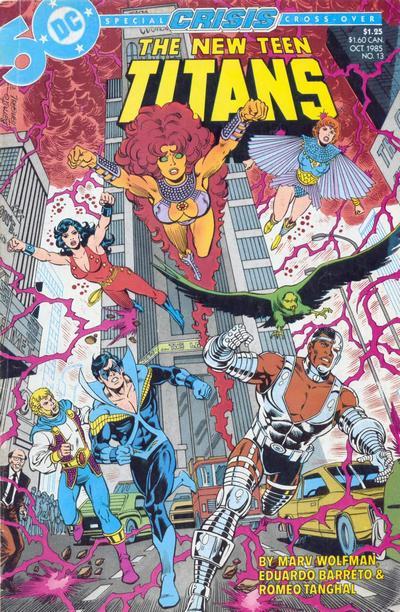
New Teen Titans Omnibus Vol 4 New Teen Titans Vol 2 10-25, Annual 1-2, Teen Titans Spotlight 1-6, Omega Men 34-35 Classic DC artist Jose Luis Garcia-Lopez follows up Perez for a short stint. Kole is introduced. But then quickly killed alongside Aquagirl and Dove in the Crisis on Infinite Earths. Which will impact some Titans history for a while. Starfire is forced into a political wedding, which pushes away Dick. Roy Harper discovers he has a daughter with the villain Cheshire. Among all this chaos, Donna Troy tries to assemble mismatched pieces like Jason Todd to lead the Titans.

New Teen Titans Omnibus Vol 5 New Teen Titans Vol 2 26-49, Annual 3-4, Infinity Inc 45 Eduardo Barreto is now the consistent artist on the book. The team finds Raven again and defeats Brother Blood again. They encounter the Wildebeest Society, which will factor heavily into the book as time goes on. An annoying kid named Danny Chase joins the team. They help out Dial H for Hero and Red Star.
Besides those JLGL issues and a few major plot points for characters, this chunk is a valley rather than a peak, but it’s not really bad. Wolfman has claimed in interviews that he was suffering from writer’s block for a few years. So there are some repetitive plots.

New Teen Titans Omnibus Vol 6 New Titans 50-69, Annual 5-6, Batman 440-441, Secret Origins Annual 3 Eduardo Barreto is gone. But who better to replace him than the return of George Perez? The side effects of the Crisis are really starting to be felt across the DCU. First on the docket is to fix Donna Troy's continuity for the second time in the Who is Wonder Girl story. She becomes Troia. The next issue addresses some Titans West stuff. Then the Secret Origins Annual recaps and fixes the entire Titans continuity post-Crisis. Perez drops off from drawing the book and then from co-plotting. He's still writing Wonder Woman and gearing up for the War of the Gods crossover, so maybe he was too busy. Bat fans should recognize those issues as half of A Lonely Place of Dying, which handed the Robin mantle to Tim Drake.
Again, another stopping point. Perez is now 100% done with the Titans besides drawing the cover for the final issue of the series. The stability of the book is about to be all over the place too.
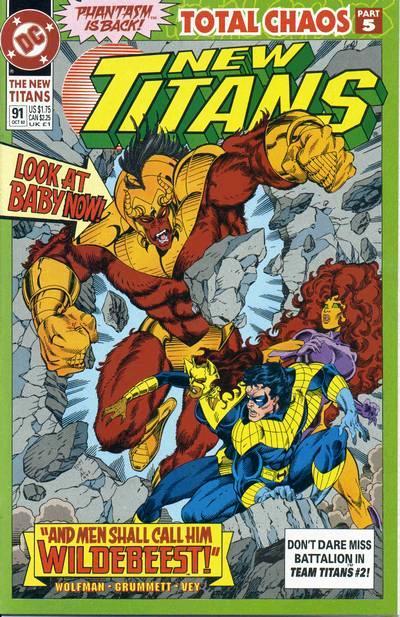
New Teen Titans Omnibus Vol 7 New Titans 70-92, Annual 8, Team Titans 1-3, Deathstroke 14-16 Two huge controversial storylines here. Tom Grummett (Superboy, Robin) is now the artist, with a more cartoony but also 90s style. The original Titans Hunt featured the Wildbeest Society hunting the Titans. Spoilers for a 30 year old story, but Jericho is revealed to be leading them. His father (Deathstroke for the clueless) kills him and helps the Titans in the finale. Some D-listers like Red Star, Pantha, Phantasm, and Baby Wildebeest join the team. Raven and Cyborg are constantly changing. Titans Tower is destroyed. Then right after that insanity, a team of weird Titans from a future timeline appear. One of them seems to be the long dead Terra. They want to kill Donna Troy because allegedly her baby is basically the Anti-Christ. Turns out that's not true and these alternate future peeps just stick around for a while.
Depending on who you ask, Titans Hunt and Total Chaos are 90s trash or an exciting uptick in the history of the Titans with a blockbuster story and lots of status quo changes. However, past this point the book officially devolves into standard 1990s fare and loses a ton of focus.

New Teen Titans Omnibus Vol 8 New Titans 93-114, Annual 9-10, Sell-Out Special, Showcase 94 11 The book is kind of shit now, but not absolute shit for some of this. A major editor left and Wolfman is running out of ideas. Roy Harper comes back and becomes Arsenal. Nightwing and Starfire get engaged, only for their wedding to be absolutely ruined by Raven. Tom Grummett leaves and is replaced by a very 90s nobody. Everyone you care about leaves the team at the end of this.
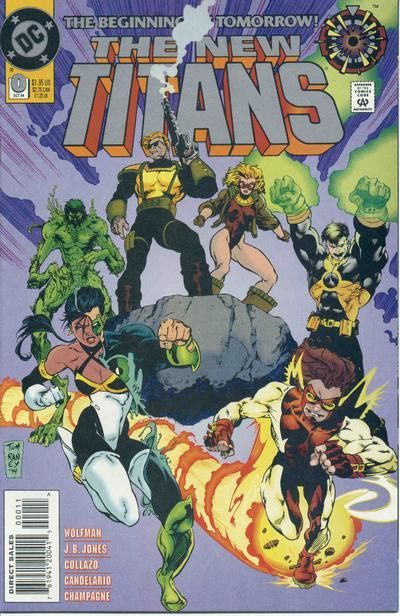
New Teen Titans Omnibus Vol 9 New Titans 0, 115-130, Annual 11, Deathstroke 48-49, Green Lantern Vol 3 65, Darkstars 32, 34, Damage 16 And we reach the end of the journey with the final volume. With a broken team and Zero Hour allowing for soft reboots, Arsenal assembles a new one. Featuring characters you like such as Donna Troy, Kyle Rayner, Impulse, Damage, and Terra (the fake one). Or at least you liked them if you were still reading comics in 1995 for some reason. That shitty 90s artist is even gone and replaced by someone tolerable. But it's totally lost the flavor that made the book so genius 10-15 years before. Fans were completely burned out from the direction and the industry at large, so the book was canceled.
My divisions are based mostly on natural cutoff points and also shooting for similar sized volumes. The three existing volumes all sit around that 24-27 issue mark.
So depending on what kind of Titans fan one is, the options would be 1-3, 1-6, 1-7, 1-8, or 1-9. It seems like each omnibus is about 3 trades, with some wiggle room.
Addendums:
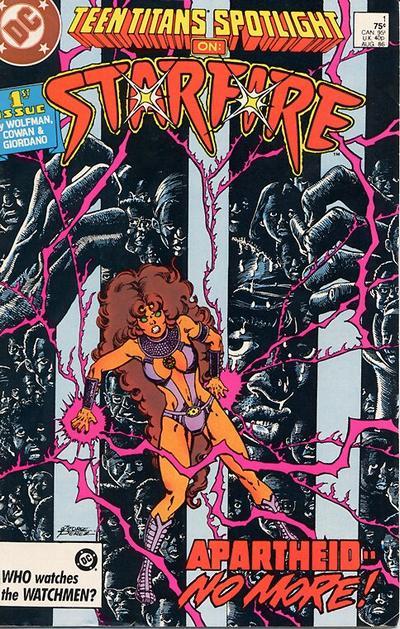
Teen Titans Spotlight is a 21 issue spinoff series created so that Titans related characters could have solo stories that wouldn't work in the context of a team book. Wolfman only wrote 1-6, an arc about Starfire dealing with South African apartheid and a Jericho arc. No other issues are really integral to the main plots. So these are the only ones that make sense in these collections, if at all.
Other semi-significant Spotlight stories though: -7-8 - Hawk in the period after his brother's death but before Dawn Granger pops up -9 - Changeling (Beast Boy) doing some more reconnecting with his Doom Patrol past -10 - Aqualad, technically does continue from a main series plot, but who cares -13 - JMS' first comics work on a Cyborg vs Two-Face story -15 - picks up on some Tamaranian plots, but effectively a minor epilogue to the 80s Omega Men series -21 - a Silver Age throwback issue from Mark Evanier and Dan Spiegle
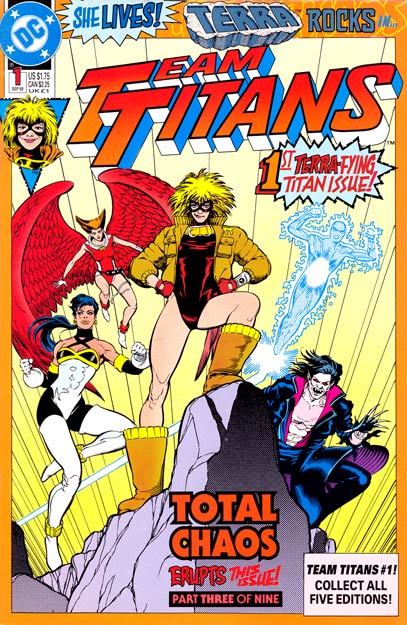
Team Titans is the book starring the alternate future characters that no one cares about besides Terra. First three issues are part of Total Chaos. The damn book somehow lasted 24 issues though. Wolfman was involved in the writing of the first half. There is really no reason to include those other 9 issues. And the series is totally pointless and bad.
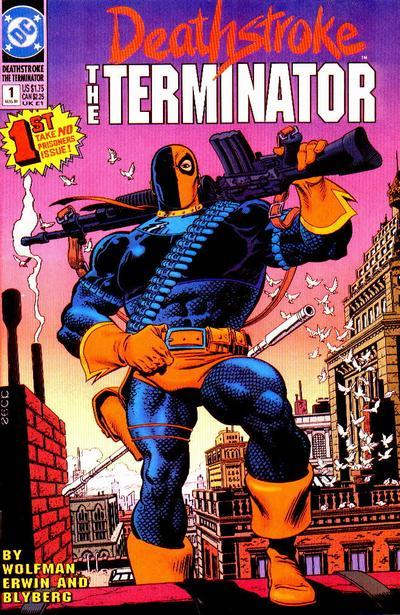
New Titans ends in 1996. Also when Wolfman's other ongoing Titans work ends. That being Deathstroke Vol 1, which lasted 60 issues. Giving the Terminator his own book was majorly inspired by the success Marvel was having with the Punisher. The first 34 issues are all drawn by the same artist, Steve Erwin. Past issue 40, Slade is framed for murder and all kinds of DCU characters try and take him down. His daughter Rose is introduced here.
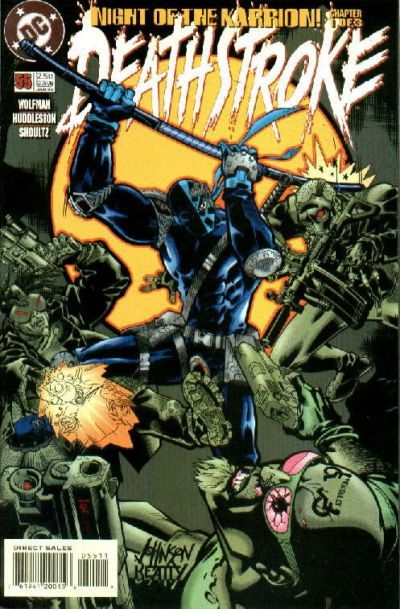
Just like the main Titans book, sales were lagging hard near the end. So they did some stupid thing where Slade literally walked out of an explosion a changed man. He was de-aged, had amnesia, a dumb new color scheme, and a new artist. It was stupid and didn't help sales.
DC has been reprinting this Deathstroke series alongside New Teen Titans. They're up to four volumes, getting to #25. The early half of this run is actually good and a decent companion piece to Titans. And obviously people are digging Rebirth Deathstroke now. Wolfman did a major plot with Batman before Christopher Priest. Avoid all N52 Deathstroke junk.
Marv Wolfman's Titans run is just over 15 years. A couple years short of Claremont's legendary X-Men run. Though Claremont also wrote and maneuvered around a wider line of closely related spinoffs. Claremont also maintained a higher average. Those first five years of NTT with Perez can rival the heights of Claremont though. Maybe blasphemous, but I find Perez more interesting than Byrne. Then there are occasional highs for another seven years or so.
For comparison, Claremont's complete original X-Men run sits at a similar 10 oversized hardcover volumes or so. Though they're a little larger on average. 1. UXM Vol 1 2. Vol 2 3. Vol 3 4. Eventual Vol 4 5. Mutant Massacre/uncollected gap 6. Fall of the Mutants 7. Inferno Prologue 8. Inferno 9. Claremont and Lee Vol 1 10. X-Tinction Agenda/Claremont and Lee Vol 2
#teen titans#titans#new titans#nightwing#starfire#robin#dick grayson#cyborg#beast boy#changeling#raven#arsenal#speedy#roy harper#marv wolfman#george perez#eduardo barreto#tom grummett#90s comics#comics#dc#dc comics#comic books#comic reading order#reading order#80s comics#1980s#1990s#omnibus
12 notes
·
View notes